A lighthouse of international radiance
German Federal Minister of Education and Research Bettina Stark-Watzinger inaugurates the new GEOMAR building
“Visible from afar, the architects gave GEOMAR Helmholtz Centre for Ocean Research Kiel a unique setting. The building reflects our mission and our self-image: Our world is the ocean. Here, under ideal conditions, we will make significant contributions at national and international level to understanding the ocean from the seafloor to the atmosphere and to developing sustainable solutions for pressing social issues. United at one location, we will drive forward our collaboration across and with all disciplines in a comprehensive and strategically orientated manner. Research Divisions, scientific disciplines, technical units and administration will plan, decide, implement and learn from each other faster and more naturally,” says GEOMAR Director Professor Dr. Katja Matthes, “We are grateful and look forward to addressing global questions from this newly created modern campus and to engaging together with partners from around the world for the protection and sustainable use of the ocean for future generations."
Today, Bettina Stark-Watzinger, German Federal Minister of Education and Research, inaugurates the new GEOMAR building after almost 20 years of planning, preparations and construction activities together with Daniel Günther, Minister President of the State of Schleswig-Holstein, Dr. Ulf Kämpfer, Lord Mayor of City of Kiel, Professor Dr. Katja Matthes, Director, and Frank Spiekermann, Administrative Director of GEOMAR, as well as about 200 invited guests.
Federal Research Minister Bettina Stark-Watzinger says: “The oceans are of central importance for life on our planet. On the one hand for the climate and biodiversity, on the other as an economic and living space. We must therefore continue to research the oceans in order to better understand, protect and sustainably use them. The Federal Ministry of Education and Research is paving the way for this with its targeted and extensive funding. Germany has a leading international role in marine research. This is due first and foremost to the excellent work of scientists at GEOMAR. With the new extension building, GEOMAR now also has a marine research campus that does justice to its scientific excellence: Large, bright and modern. With plenty of space for new goals and the best conditions for innovative solutions to protect the oceans.”
Minister President Daniel Günther says: “We are proud that one of the best marine science institutes of the world is located in Schleswig-Holstein. With this new campus, GEOMAR will secure its leading position in global ocean research in the long term. It will make our state and the city of Kiel even more visible as a centre of marine science and attract many talented people and experts to us in Germany’s True North. As a state between two seas, we are very keen to offer best working conditions here. The maritime sector is of the highest strategic importance for Schleswig-Holstein. Therefore, we as a state were very happy to invest in this expansion.”
Since the move at the end of 2023, all four GEOMAR research divisions, administration and central facilities have been united at one location at the Seefischmarkt on Kiel's eastern shore. The modern infrastructure with various laboratories, climate chambers and seawater supply, as well as conference area, library, computer centre and numerous places for scientific exchange fosters the excellence of the scientific work at GEOMAR. The building, designed by Staab Architekten GmbH, will have an impact far beyond the state capital of Kiel. The total cost of the project, amounting to around 140 million euros (net), is being funded 90 per cent by the federal government and 10 per cent by the state of Schleswig-Holstein.
At the inauguration ceremony, the typhoon, which also loudly announces the start of Kiel Week, is sounded as a signal matching the location and the building. Of course, a response from GEOMAR's research vessels is a must – because from their home port of Kiel, GEOMAR scientists investigate the global ocean system in its entirety, from the seafloor to the atmosphere.
Dr. Ulf Kämpfer, Lord Mayor City of Kiel, says: “The typhoon’s signal is already music to my ears, because we use it to open our unique Kiel Week every year. Now it also marks the official start for the future viability of ocean research in this modern new building, for which I offer my warmest congratulations. With both our diverse summer festival and this outstanding research centre, we are visible far beyond the city limits – this makes us attractive as a state capital and strengthens our reputation as a city of marine conservation. This expertise is a fortunate coincidence for us and should also be incorporated into the development process of our planned marine visualisation centre.”
Insights into the diverse research topics at GEOMAR
After the inauguration ceremony, guests gain insights into current topics at GEOMAR. These include research into approaches for the uptake and storage of carbon dioxide in the ocean to mitigate climate change, for example in the research mission “Marine carbon sinks in decarbonisation pathways” (CDRmare) of the German Marine Research Alliance (Deutsche Allianz Meeresforschung, DAM), which is coordinated at GEOMAR and funded by the German Federal Ministry of Education and Research (BMBF), as well as in many other national and international projects.
Also shown is work on the recovery of munitions from the Baltic and North Seas with the research network “CONcepts for conventional MArine Munition Remediation in the German North and Baltic Sea” (CONMAR) coordinated at GEOMAR as part of the DAM research mission “Protection and Sustainable Use of Marine Areas” (sustainMare). In addition, research on resources and the protection of the deep sea in the project “MiningImpact” of the European Joint Programming Initiative Healthy and Productive Seas and Oceans (JPI Oceans) as well as GEOMAR's involvement in processes at the International Seabed Authority (ISA) are presented. New approaches for the use of observational data are demonstrated, for example using digital twins to investigate what-if scenarios and various data platforms. GEOMAR technology transfer participates with the aspects of artificial intelligence, such as the robot dog SPOT-KI, and ocean observation.
A particular focus is placed on research in Cabo Verde, where GEOMAR has been working closely with science, politics and society for almost 20 years. Since 2017, the Ocean Science Centre Mindelo (OSCM) has been operated as a base for field research in the tropical northeast Atlantic, scientific exchange, university education and networking with West Africa. In Mindelo, the international Master's programme “Climate Change and Marine Sciences” is offered to young researchers from West Africa with funding from the BMBF as part of the West African Science Service Centre on Climate Change and Adapted Land Use (WASCAL). In this globally and regionally important marine region with its upwelling system, GEOMAR and its international partners are planning the year-round research mission “The Future of Tropical Upwelling Regions in the Atlantic Ocean” (FUTURO), closely involving regional expertise. The importance of research in Cabo Verde and the OSCM for the region is also acknowledged by the musical programme at the inauguration.
“This day of joy is also a day to look back,” explains GEOMAR Director Professor Dr. Katja Matthes. “We would like to thank those who have made GEOMAR a leading international institution over the decades. We are proud of the excellent ratings and the motivation we obtain in reviews and will continue to advance the development and integration of Kiel's marine sciences with curiosity and creativity. We would like to thank in particular the Federal Ministry of Education and Research and the state of Schleswig-Holstein for their continued support.”
Looking back: Two locations become one world-leading research centre
The move into the new building marked the end of the spatial division of today's GEOMAR. Its roots go back to the founding of the “Laboratory for International Marine Research” by Otto Krümmel in 1902. The first “Institute of Oceanography” was established in 1937 in Kitzeberg as an institute of Kiel University. After a bombing raid, in which director Hermann Wattenberg and nine of his colleagues lost their lives, the researchers continued their work under the direction of Georg Wüst in Hohenbergstraße in Kiel-Düsternbrook from 1946.
In addition to its focus on physical oceanography, the “Institute of Oceanography” covered a wide range of chemical and biological questions. In 1968, it was transferred to an institute of the “Blaue Liste" (the later Leibniz Association) and thus placed under the funding of the state of Schleswig-Holstein and the Federal Republic of Germany. In 1972, it received its own building with an aquarium and seal basin directly at the Kiellinie.
As interest in marine geological topics grew from the 1960s onwards, several initiatives were launched at Kiel University to expand knowledge about the seafloor and processes extending into the Earth's interior. Finally, in 1984, a working group of the Geological Commission of the Senate of the German Research Foundation (DFG) recommended the foundation of a separate institute. Following this recommendation, the Schleswig-Holstein state parliament unanimously voted in favour of a “Research Centre for Marine Geosciences GEOMAR” as a foundation under public law in Kiel in July 1987. Professor Dr Jörn Thiede was appointed as founding director.
The nucleus of the GEOMAR of those days was Building 4 at the Seefischmarkt. The new branch grew quickly and expanded to other buildings on the site. In 1996, after only four years of construction, Building 8 was completed.
The idea of merging the two locations was already present in 2004, when the Leibniz Institute of Marine Sciences IFM-GEOMAR was founded from the Institute of Oceanography (IfM) and the Research Centre for Marine Geosciences GEOMAR. However, the change from the Leibniz to the Helmholtz Association required a new start of the planning process. Finally, in 2012, an architectural competition was organised, won by the Staab Architekten GmbH.
The ground-breaking ceremony for the new building was held on 27 March 2017. The core and rock repository and multi-storey car park were inaugurated on 28 September 2021. The fire that broke out during roof work on 13 September 2022 caused a setback, requiring renovation work on the façade and in some rooms even before the move. Nevertheless, the move was largely completed by the end of 2023. The final component of the project, the 1,400-metre-long sea water pipeline, will be put into operation in spring 2025.
Facts about the new extension building
- 5 towers, total length 128 metres, total width 63 metres, height up to 26 metres
- Usable area: approx. 15,500 square metres
- 21 conference and meeting rooms
- 230 offices for about 500 employees
- 166 laboratories and 18 climate chambers
- Seawater pipeline: approx. 1,400 metres
- Seawater basin: 200 cubic metres
- 2 berths for research vessels
- One of the largest public marine science libraries in Germany
- Computer centre with currently five petabytes of storage space

Proud of the new lighthouse for marine research (from left): Dr Ulf Kämpfer, Lord Mayor of the City of Kiel, Frank Spiekermann, Administrative Director of GEOMAR, Bettina Stark-Watzinger, Federal Minister of Education and Research, Professor Dr Katja Matthes, Director of GEOMAR, Daniel Günther, Minister President of the State of Schleswig-Holstein, and Karin Prien, Minister of Education of the State of Schleswig-Holstein. Photo: Thomas Eisenkrätzer, GEOMAR
Excellently equipped, inspiring and the best environment for an engagement across disciplines for the protection and sustainable use of the ocean - this is the new GEOMAR building.
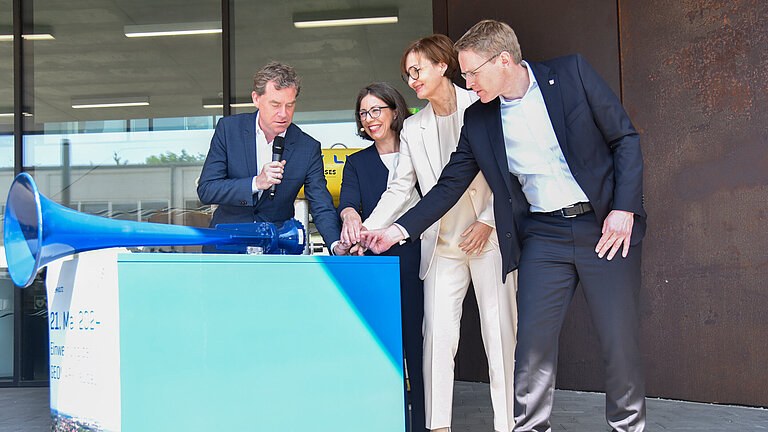
At the inauguration ceremony, the typhoon, which also loudly announces the start of Kiel Week, sounds in keeping with the location and the building. From the left: Dr Ulf Kämpfer, Lord Mayor of the City of Kiel, Professor Dr Katja Matthes, Director of GEOMAR, Bettina Stark-Watzinger, Federal Minister of Education and Research, Daniel Günther, Minister President of the State of Schleswig-Holstein. Photo: Thomas Eisenkrätzer, GEOMAR

Before the inauguration of the new GEOMAR building: Dr Ulf Kämpfer, Lord Mayor of the City of Kiel, Karin Prien, Research Minister of the State of Schleswig-Holstein, Daniel Günther, Minister President of the State of Schleswig-Holstein, Bettina Stark-Watzinger, Federal Minister of Education and Research, Prof. Dr Katja Matthes, Director of GEOMAR, Frank Spiekermann, Administrative Director of GEOMAR (from left). Photo: Thomas Eisenkrätzer
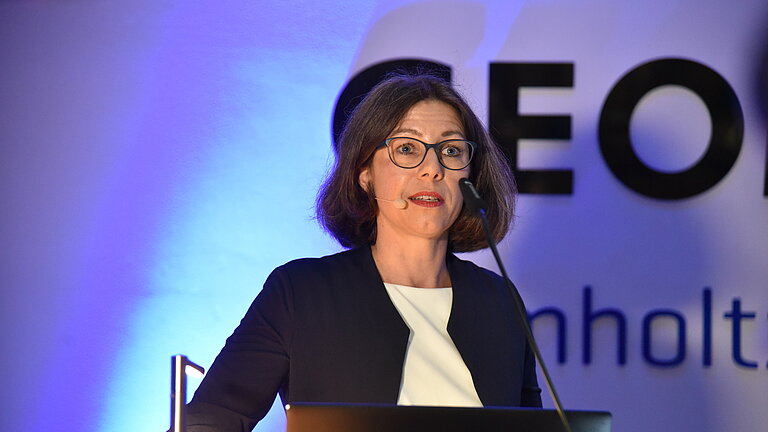
“We are grateful and look forward to addressing global questions from this newly created modern campus and to engaging together with partners from around the world for the protection and sustainable use of the ocean for future generations", says GEOMAR Director Professor Dr. Katja Matthes. Photo: Thomas Eisenkrätzer, GEOMAR
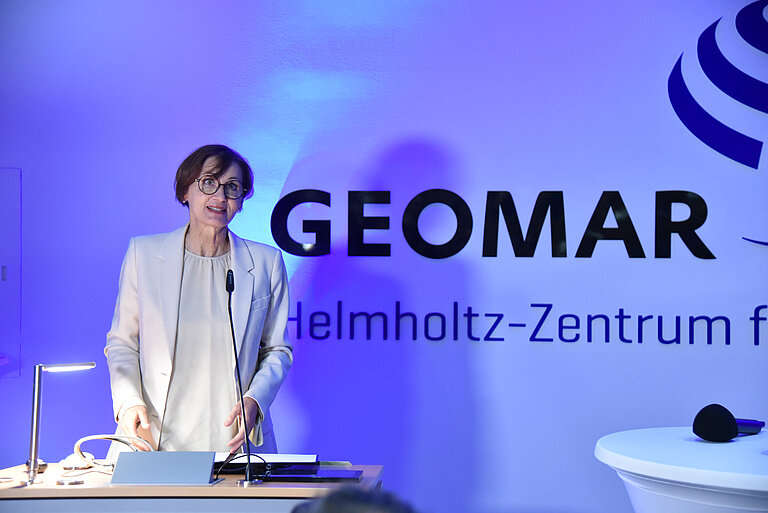
"With the new extension, GEOMAR has a marine research campus that does justice to its scientific excellence: Large, bright and contemporary," says Bettina Stark-Watzinger, Federal Minister of Education and Research. Photo: Thomas Eisenkrätzer, GEOMAR
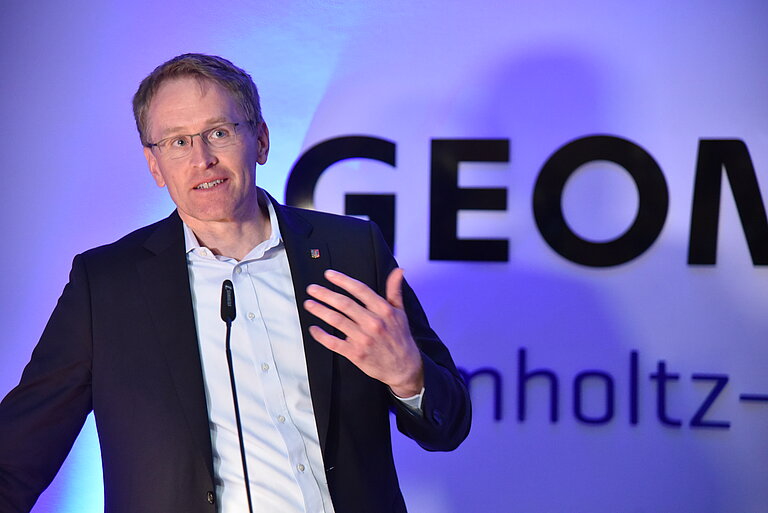
“We are proud that one of the best marine science institutes of the world is located in Schleswig-Holstein. With this new campus, GEOMAR will secure its leading position in global ocean research in the long term", says Daniel Günther, Minister President of Schleswig-Holstein. Photo: Thomas Eisenkrätzer, GEOMAR
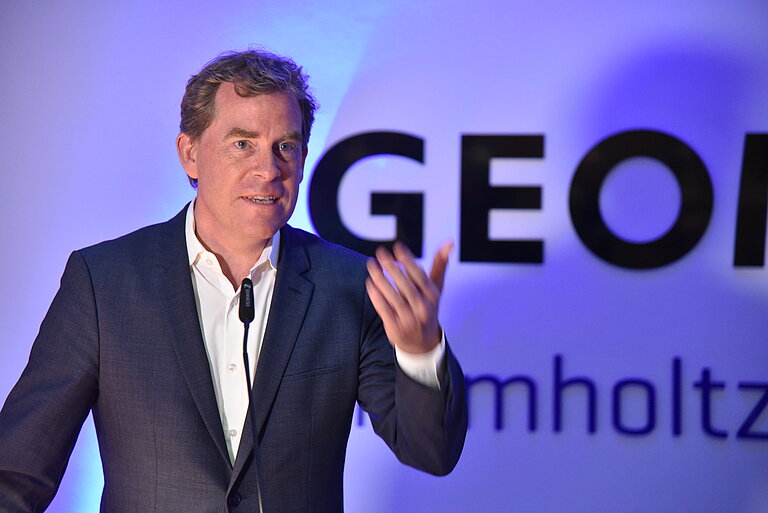
"The typhoon’s signal is already music to my ears, because we use it to open our unique Kiel Week every year. Now it also marks the official start for the future viability of ocean research in this modern new building, for which I offer my warmest congratulations", says Kiel's lord Mayor Dr. Ulf Kämpfer. Photo: Thomas Eisenkrätzer
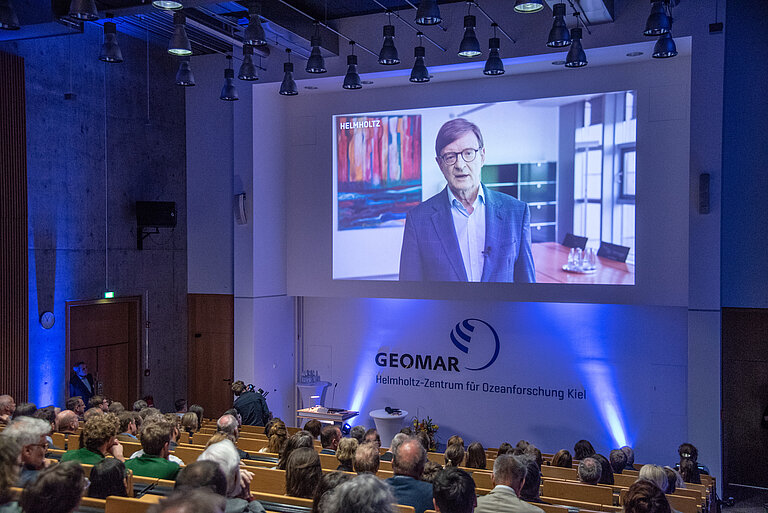
Prof Dr Otmar Wiestler, President of the Helmholtz Association, congratulated via video message. Photo: Thomas Eisenkrätzer, GEOMAR
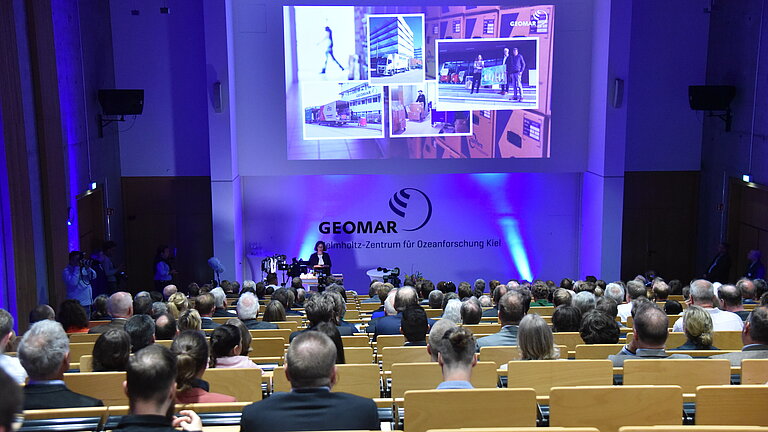
Since the move at the end of 2023, all four GEOMAR research divisions, administration and central facilities have been united at one location on Kiel's eastern shore. Photo: Thomas Eisenkrätzer, GEOMAR
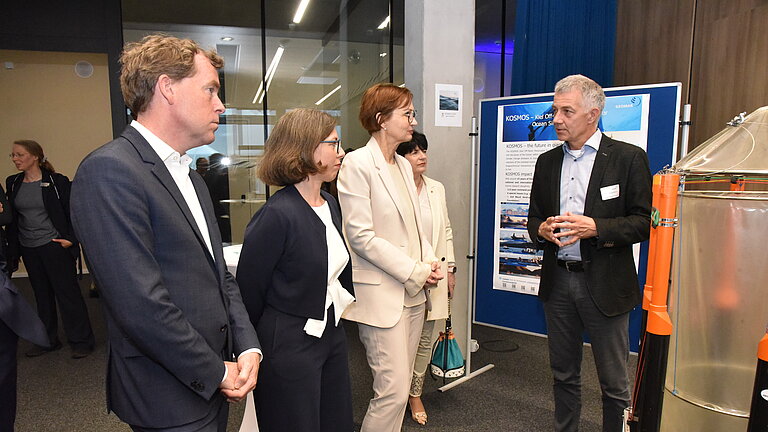
Minister Bettina Stark-Watzinger honoured GEOMAR's research on marine carbon storage, for example in the research mission CDRmare of the German Marine Research Alliance (DAM). Photo: Thomas Eisenkrätzer, GEOMAR

GEOMAR's technology transfer presented itself with the topic of artificial intelligence, such as the robot sniffer dog SPOT-KI. Photo: Thomas Eisenkrätzer, GEOMAR
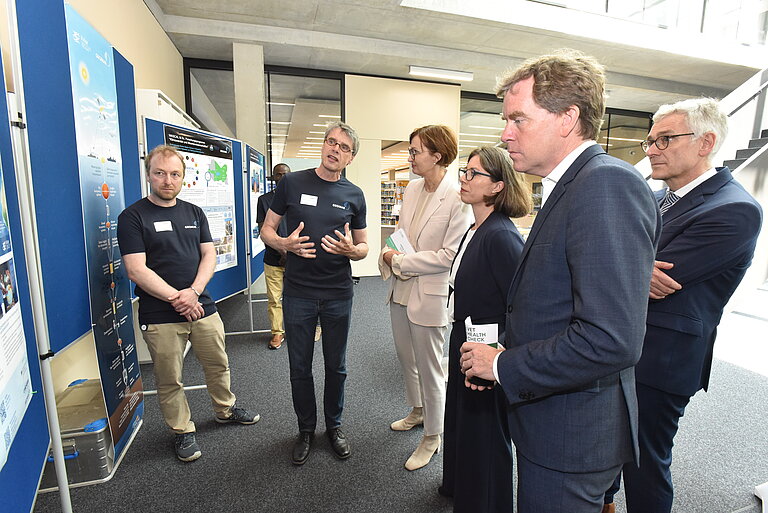
During her tour, Minister Bettina Stark-Watzinger informed herself about the research of GEOMAR and its partners in Cabo Verde. Photo: Thomas Eisenkrätzer, GEOMAR
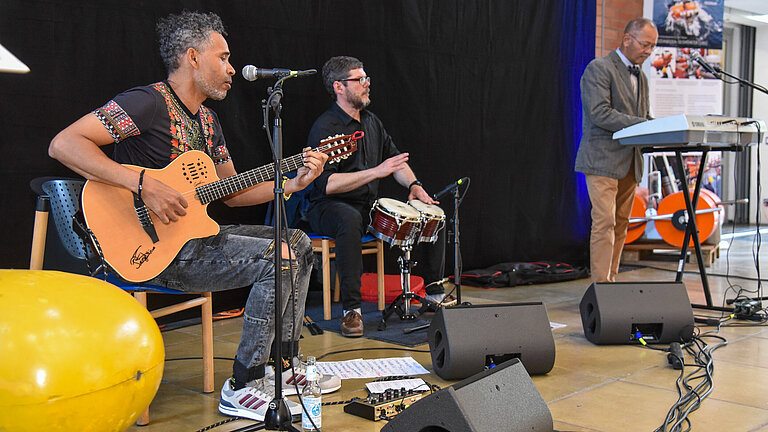
The band "Pol and Friends" brought Cape Verdean flair to Kiel and built a bridge to the archipelago, which has a long-standing research collaboration with GEOMAR. Photo: Thomas Eisenkrätzer, GEOMAR

Volker Staab from Staab Architekten GmbH gave a short welcome speech during the inauguration ceremony. Photo: Thomas Eisenkrätzer, GEOMAR
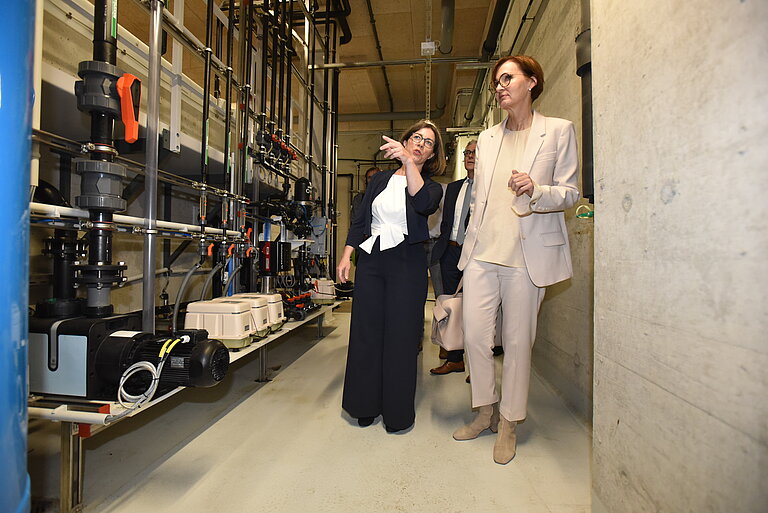
Federal Research Minister Bettina Stark-Watzinger (right) and GEOMAR Director Professor Dr Katja Matthes taking a look behind the scenes: The seawater centre supplies the researchers for their experiments in the new GEOMAR building. Photo: Thomas Eisenkrätzer, GEOMAR

Aerial photo of the new building in May 2024. Photo: Sarah Uphoff, GEOMAR

Aerial photo of the new building with research vessel ALKOR. Photo: Jens Klimmeck, GEOMAR
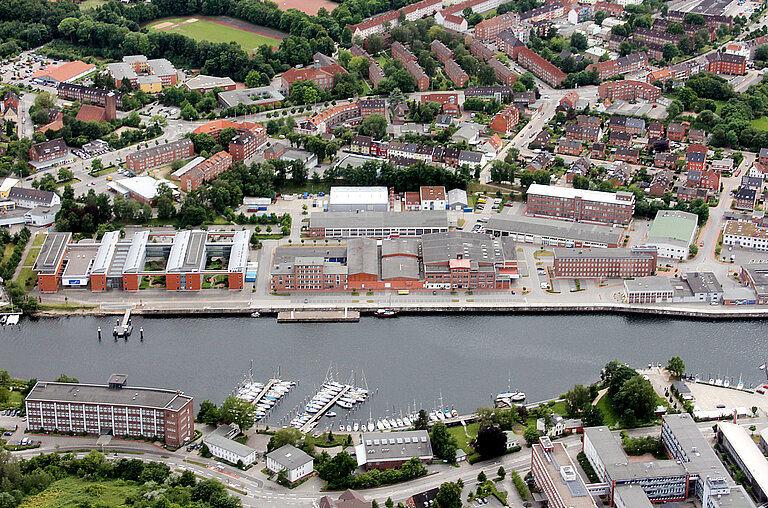
Aerial photo of the area before the start of the construction work. Photo: Andreas Villwock, GEOMAR

First prize in the architectural competition went to the design by Staab Architekten GmbH, shown here in the model. Photo: Jan Steffen, GEOMAR

The construction site in February 2018. Photo: Ralf Schwarz, GEOMAR
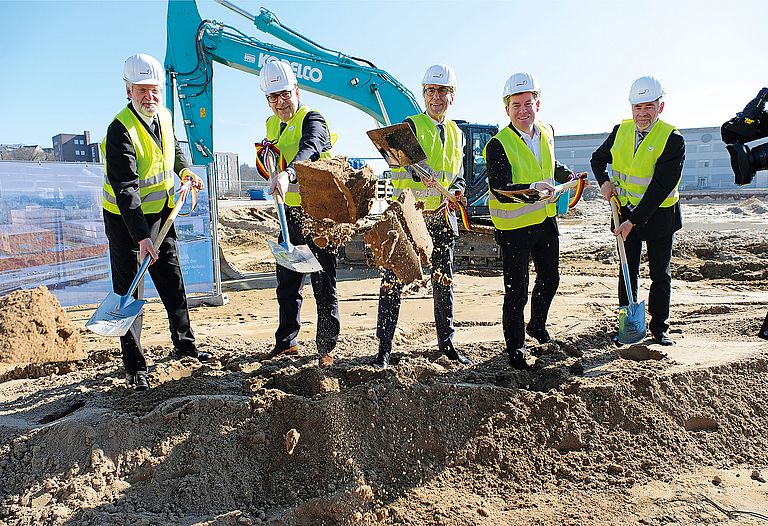
Groundbreaking ceremony for the new GEOMAR building on 27.03.2017. From left: Former GEOMAR Director Prof. Dr. Peter Herzig, Schleswig-Holstein's Prime Minister Torsten Albig, MinDir. Dr. Karl Eugen Huthmacher from the BMBF, Kiel's Lord Mayor Ulf Kämpfer and GEOMAR Administrative Director Michael Wagner. Photo: Jan Steffen, GEOMAR
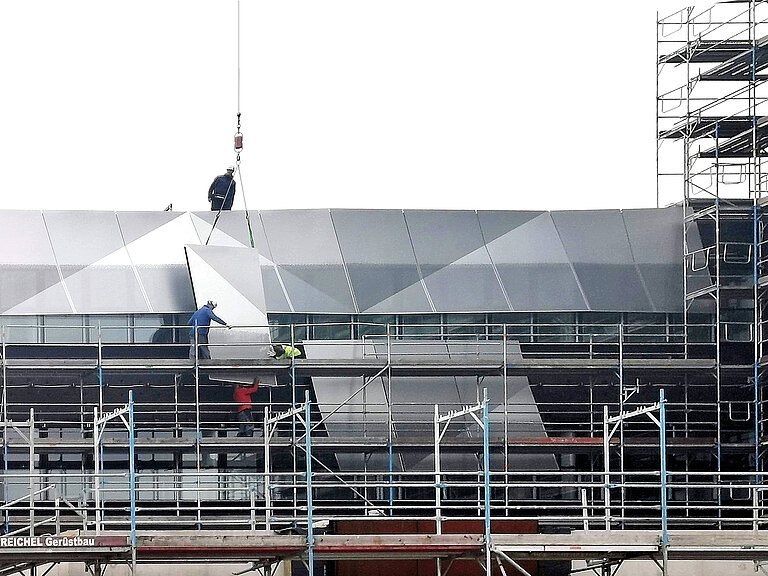
Installation of the aluminium façade elements on Tower 4 in autumn 2019. Photo: Armin Form, GEOMAR

Moving into the new building in autumn 2023. Photo: Sarah Uphoff, GEOMAR
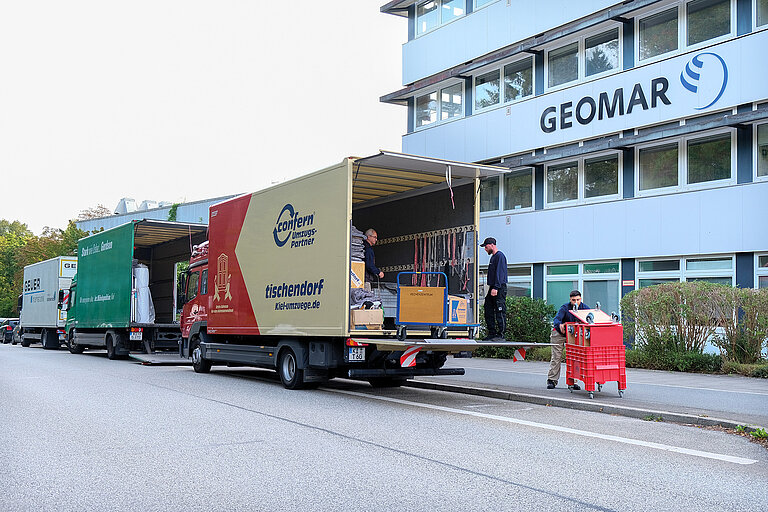
Boxes are being picked up at the west shore building. Photo: Nele Becker, GEOMAR


